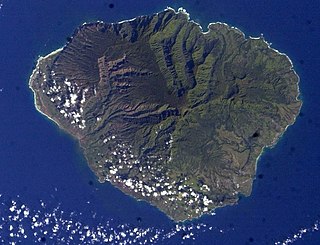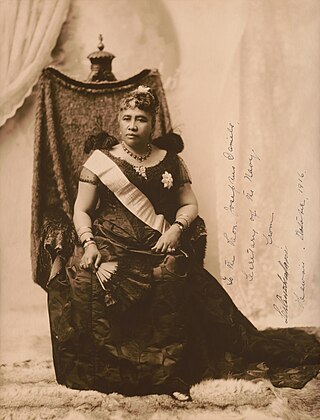
Hawaii is an island state in the Western United States, about 2,000 miles (3,200 km) from the U.S. mainland in the Pacific Ocean. It is the only U.S. state outside North America, the only one which is an archipelago, and the only one in the tropics.

Honolulu is the capital and most populous city of the U.S. state of Hawaii, which is in the Pacific Ocean. It is the unincorporated county seat of the consolidated City and County of Honolulu, situated along the southeast coast of the island of Oʻahu, and is the westernmost and southernmost major U.S. city. Honolulu is Hawaii's main gateway to the world. It is also a major hub for business, finance, hospitality, and military defense in both the state and Oceania. The city is characterized by a mix of various Asian, Western, and Pacific cultures, reflected in its diverse demography, cuisine, and traditions.
Hawaiian is a Polynesian language and critically endangered language of the Austronesian language family that takes its name from Hawaiʻi, the largest island in the tropical North Pacific archipelago where it developed. Hawaiian, along with English, is an official language of the US state of Hawaii. King Kamehameha III established the first Hawaiian-language constitution in 1839 and 1840.

Oahu is the third-largest of the Hawaiian Islands. The island of Oʻahu and the Northwestern Hawaiian Islands constitute the City and County of Honolulu. The state capital, Honolulu, is on Oʻahu's southeast coast. Oʻahu has a population of 995,638, up from 953,207 in 2010.

Kauaʻi, anglicized as Kauai, is geologically the second-oldest of the main Hawaiian Islands. With an area of 562.3 square miles, it is the fourth-largest of the islands and the 21st-largest island in the United States. Nicknamed the Garden Isle, Kauaʻi lies 73 miles across the Kauaʻi Channel, northwest of Oʻahu. It is the site of Waimea Canyon State Park and the Na Pali Coast State Park.

Hawaii is the largest island in the United States, located in the eponymous state of Hawaii. It is the southeasternmost of the Hawaiian Islands, a chain of volcanic islands in the North Pacific Ocean. With an area of 4,028 square miles (10,430 km2), it has 63% of the Hawaiian archipelago's combined landmass. However, it has only 13% of the archipelago's population. The island of Hawaiʻi is the third largest island in Polynesia, behind the north and south islands of New Zealand.

Hawaiian Airlines is a commercial U.S. airline, headquartered at Honolulu, Hawaii. It is the largest operator of commercial flights to and from the island state of Hawaii, and the tenth-largest commercial airline in the United States.

The Hawaiian Islands are an archipelago of eight major volcanic islands, several atolls, and numerous smaller islets in the North Pacific Ocean, extending some 1,500 miles from the island of Hawaiʻi in the south to northernmost Kure Atoll. Formerly called the Sandwich Islands, the present name for the archipelago is derived from the name of its largest island, Hawaiʻi.

The flag of Hawaii was first adopted in the early 19th century by the Hawaiian Kingdom and continued to be used after its overthrow in 1893. It is the only U.S. state flag to feature a foreign country's national flag—that of the United Kingdom's Union Jack—which commemorates the Royal Navy's historical relations with the Kingdom of Hawaii, and in particular the pro-British sentiment of its founder and first ruler, King Kamehameha I.

Liliʻuokalani was the only queen regnant and the last sovereign monarch of the Hawaiian Kingdom, ruling from January 29, 1891, until the overthrow of the Hawaiian Kingdom on January 17, 1893. The composer of "Aloha ʻOe" and numerous other works, she wrote her autobiography Hawaiʻi's Story by Hawaiʻi's Queen during her imprisonment following the overthrow.
Located about 2300 miles (3680 km) from the nearest continental shore, the Hawaiian Islands are the most isolated group of islands on the planet. The plant and animal life of the Hawaiian archipelago is the result of early, very infrequent colonizations of arriving species and the slow evolution of those species—in isolation from the rest of the world's flora and fauna—over a period of at least 5 million years. As a consequence, Hawai'i is home to a large number of endemic species. The radiation of species described by Charles Darwin in the Galapagos Islands which was critical to the formulation of his theory of evolution is far exceeded in the more isolated Hawaiian Islands.

The Territory of Hawaii or Hawaii Territory was an organized incorporated territory of the United States that existed from April 30, 1900, until August 21, 1959, when most of its territory, excluding Palmyra Island, was admitted to the United States as the 50th U.S. state, the State of Hawaii. The Hawaii Admission Act specified that the State of Hawaii would not include Palmyra Island, the Midway Islands, Kingman Reef, and Johnston Atoll, which includes Johnston Island and Sand Island.

Native Hawaiians are the indigenous Polynesian people of the Hawaiian Islands.

The Hawaiian sovereignty movement is a grassroots political and cultural campaign to reestablish an autonomous or independent nation or kingdom of Hawaii out of a desire for sovereignty, self-determination, and self-governance. Some groups also advocate some form of redress from the United States for its 1893 overthrow of Queen Lili'uokalani, and for what is described as a prolonged military occupation beginning with the 1898 annexation. The movement generally views both the overthrow and annexation as illegal. Palmyra Atoll and Sikaiana were annexed by the Kingdom in the 1860s, and the movement regards them as under illegal occupation along with the Hawaiian Islands. The Apology Resolution the United States Congress passed in 1993 acknowledged that the overthrow of the Hawaiian Kingdom was an illegal act.
Genophantis leahi was a species of moth in the family Pyralidae described by Otto Herman Swezey in 1910. It was endemic to the Hawaiian islands of Maui, Oahu, Molokai and Hawaii.

Pearl Harbor is an American lagoon harbor on the island of Oahu, Hawaii, west of Honolulu. It was often visited by the Naval fleet of the United States, before it was acquired from the Hawaiian Kingdom by the U.S. with the signing of the Reciprocity Treaty of 1875. Much of the harbor and surrounding lands are now a United States Navy deep-water naval base. It is also the headquarters of the United States Pacific Fleet. The U.S. government first obtained exclusive use of the inlet and the right to maintain a repair and coaling station for ships here in 1887. The surprise attack by the Imperial Japanese Navy on December 7, 1941, led the United States to declare war on the Empire of Japan, making the attack on Pearl Harbor the immediate cause of the United States' entry into World War II.

The Hawaiian Kingdom, or Kingdom of Hawaiʻi, was a sovereign state located in the Hawaiian Islands. The country was formed in 1795, when the warrior chief Kamehameha the Great, of the independent island of Hawaiʻi, conquered the independent islands of Oʻahu, Maui, Molokaʻi and Lānaʻi and unified them under one government. In 1810, the whole Hawaiian archipelago became unified when Kauaʻi and Niʻihau joined the Hawaiian Kingdom voluntarily. Two major dynastic families ruled the kingdom: the House of Kamehameha and the House of Kalākaua.

Hawaii Five-0 is an American action police procedural television series that centers around a special police major crimes task force operating at the behest of the governor of Hawaii. It is a reboot of the 1968–1980 series Hawaii Five-O, which also aired on CBS. The series was produced by K/O Paper Products and 101st Street Television, initially in association with CBS Television Studios. The show received praise for its modern take on the original series.
Genophantis iodora is a moth of the family Pyralidae described by Edward Meyrick in 1888. It is endemic to the Hawaiian islands of Kauai, Oahu, Molokai and Hawaii.











